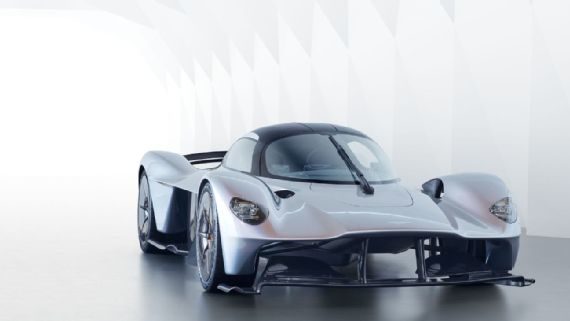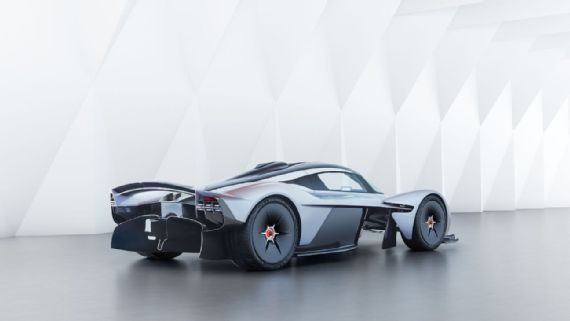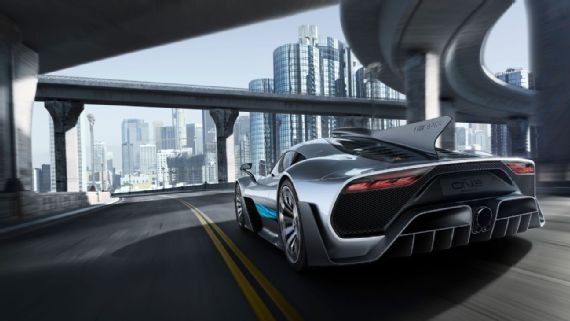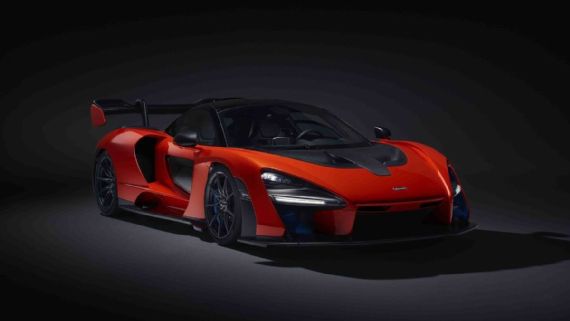
The new breed of F1-inspired road cars
For those lucky enough to be in the market for a hypercar, there has never been a better time to purchase one with genuine Formula One pedigree. In a break from writing about the Halo, ‘grid girls’ and F1 launch dates, we take a closer look at the three F1-inspired hypercars set to hit the highways in the next two years.
F1 connection
Valkyrie stats
Engine: Cosworth-built 6.5-litre, naturally aspirated V12
Hybrid: Rimac-built KERS
Power: 1,130bhp*
Weight: 1,030kg*
BHP per tonne: 1,097*
Price: £2.5m
Production run: 150 plus 25 AMR Pros
*According to unconfirmed reports
When F1 design genius Adrian Newey became frustrated with Formula One’s increasingly restrictive rule book, his Red Bull bosses agreed to let his talents loose on new projects. One of those projects was working with Aston Martin to build the ultimate road car, and the Valkyrie is the end product.
While road-going vehicles have to comply with crash tests and emissions regulations, the opportunity to experiment with aerodynamics — Newey’s forte — is pretty much wide open. That much is evident in the remarkable shape of the Valkyrie’s aerodynamic surfaces — specifically its floor, which has been sculpted into two giant Venturi tunnels at the rear.
At the original announcement of the Valkyrie — then codenamed AM-RB 001 — Aston Martin claimed its new car would break the Formula One lap record at Silverstone, although that target now appears to be the aim of the track-only Valkyrie AMR Pro. Still, the performance of the ‘standard’ Valkyrie is likely to exceed that of any other car on the road.
Verdict
The Aston Martin Valkyrie has parallels with the legendary McLaren F1. Back in the 1990s, McLaren’s F1 completely rewrote the rules surrounding performance road cars and the Valkyrie promises to do the same. Legendary F1 designer Gordon Murray was the man behind the F1 and the Valkyrie looks set to create a similar legacy for Newey.
The fact it has a bespoke naturally-aspirated V12 only adds to the appeal at a time when the majority of performance car manufacturers look to forced induction to meet their power demands. With the advent of a new era of electric vehicles already upon us, the Valkyrie could prove to be the ultimate swansong for the internal combustion engine.
F1 connection
Project One stats
Engine: Brixworth-built 1.6-litre, single turbo V6
Hybrid: F1-derived MGU-K and MGU-H
Power: 1,000bhp plus
Weight: Approx 1,300kg
BHP per tonne: Approx 770
Price: £2.4m
Production run: 275
Car manufacturers often boast about the links between their motorsport endeavours and their production cars, but it’s rare that they simply lift hardware from an F1 car and plonk it in a road-going vehicle. The reasons for that are clear: an F1 car is intended to be thrashed from the moment it starts to the moment it’s shut down and each part of it is designed to last just a few miles longer than required under the regulations. A road car, meanwhile, is designed to be driven around town at low speeds, meet emissions regulations and last as long as the car is cared for.
Therefore, it is testimony to the engineering brilliance of Mercedes’ world-beating turbo hybrid F1 engine that it can be adapted to run in a road car. There will be some changes to the engine — the red line will be capped at 11,000rpm in the Project One compared to 13,500 in the F1 car and the fuel-flow limiter will be removed — but the basic 1.6-litre V6 and its single split turbo will remain. The Energy Recovery System will actually be improved with a bigger battery and an electric motor on each of the front wheels — capable of both recovering energy under braking and delivering 120kW of power under acceleration. In its most frugal engine setting, the Project One will be able to travel 25km on electric power alone and it will be by far the most efficient hypercar on the market when it hits the road in 2019.
Verdict
Any road car powered by an F1 engine achieves instant legendary status. The Ferrari F50 had a V12 based on the Scuderia’s 1990 F1 engine, the Porsche Carrera GT had an engine derived from a stillborn V10 project for Footwork (which eventually ended up in a Le Mans prototype), but it’s incredibly rare to see an F1 power unit as complete as the Project One’s make it onto the road. The new Mercedes is the closest you can get to driving a modern F1 car on public highways, and it achieves that with unprecedented levels of fuel efficiency for a hypercar.
F1 connection
Senna stats
Engine: Ricardo-built 4.0-litre, twin-turbo V8
Hybrid: No
Power: 789bhp
Weight: 1,198kg
BHP per tonne: 660
Price: £750,000 (final example auctioned for £1.88m)
Production run: 500
It’s perhaps unfair to pit the McLaren Senna against the other two cars on this list (it is roughly £1.65m cheaper than both!), but with that name it simply couldn’t be ignored. The Senna name has been used with the blessing of three-time world champion’s family and McLaren has promised to donate a “significant contribution” to the Instituto Ayrton Senna as part of its collaboration with the foundation.
The British manufacturer launched the Senna earlier this year saying it was the “personification of McLaren’s DNA at its most extreme” and “the most track-focused road car we have ever built”. Much like an F1 car, every surface has been designed to make it go faster on track, giving the Senna its aggressive — if slightly ungainly — looks. Like-for-like technology with an F1 car is limited — it isn’t a hybrid for starters — but McLaren has approached the design of the Senna in the same uncompromising way it does with its race cars, making it one of the most outrageous production cars in existence.
Verdict
Naming a car after Ayrton Senna is brave. But McLaren’s thinking was clear: this is the most track-focused road car it’s ever built and Senna was the most intense racing driver it ever employed. Because of the name, the Senna has a hint of the Ferrari Enzo about it, but unlike the legendary Enzo, which was the ultimate Ferrari at the time of its launch, McLaren is already working on a car that will sit above the Senna in its range.
BP23 is the codename for McLaren’s upcoming three-seater hypercar, which will be the natural successor to the McLaren P1 and the legendary McLaren F1 before that. With over 1,000bhp, the BP23 will be more powerful than the Senna, but being McLaren’s ultimate road car it is unlikely to match the Senna’s track-focussed performance on a flying lap. Perhaps the Senna’s ability to set new production car lap records will justify McLaren’s bold nomenclature, but with its divisive looks and the BP23 in the pipeline there’s still a question over whether the it’s special enough to carry that name.
source:http://kwese.espn.com/f1/story/_/id/22285117/the-new-breed-f1-inspired-road-cars






